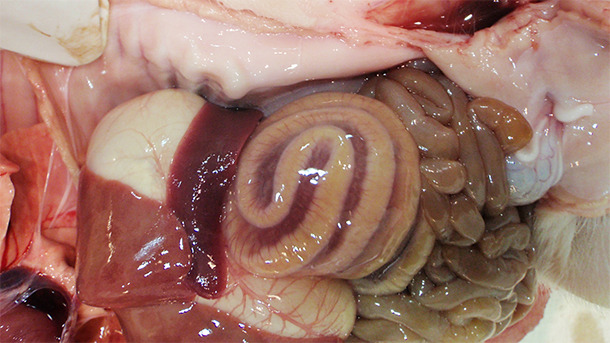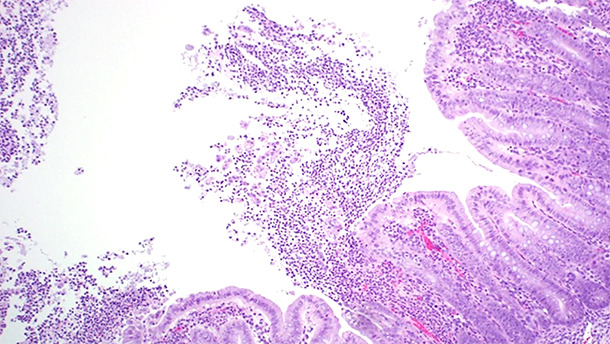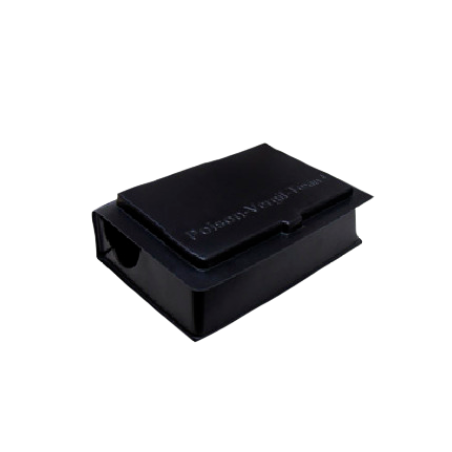Clostridium difficile is a Gram positive, anaerobic, spore-forming bacterium. Enteric disease due to C. difficile is known to affect several species including humans, pigs, horses, non-human primates, rabbits, rats, domestic dogs and domestic cats(Arroyo et al., 2005; Debast et al., 2009; Hopman et al., 2011; Keessen et al., 2011a; Norman et al., 2009) .
In swine, C. difficile infection (CDI) is one of the most important enteric diseases of the neonate. CDI in swine is predominately observed in 1-7 day-old piglets (Hopman et al., 2011; Songer and Anderson, 2006). Clinical signs include yellow to watery diarrhea and constipation (Yeager 2007). C. difficile intestinal colonization occurs within the first hours-of-life, and nearly one hundred percent of piglets in some herds are colonized within 48 hours-of-birth (Hopman et al., 2011); however, clinical disease is only observed in specific circumstances. Transmission is fecal-oral and the bacterial and spores are often endemic within the farm environment. It has been showed that only approximately 25% of sows tested were actively shedding C. difficile during lactation (Norman et al., 2009). Other studies have shown that ambient air and the environment are the main source of C. difficile to neonatal pigs (Hopman et al., 2011). C. difficile spores are highly resistant to physical and chemical agents such as farm cleaning procedures and most common disinfectants (Fawley et al., 2007) and can survive for many months in the environment (Speight et al., 2011). The prevalence of C. difficile carriage among swine drops dramatically with age. Studies in a variety of countries investigating the prevalence of C. difficile in slaughter pigs revealed a consistently low prevalence, ranging from 0% to 8% (Baker et al., 2010; Hoffer et al., 2010).

Despite the majority of C. difficile cases occur in the first week-of-life, Arruda and others (2013) in a recent study demonstrated that 10 day-old piglets are as susceptible as neonatal piglets when challenged with a toxigenic strain of C. difficile. Numerous virulence factors associated with CDI have been described including surface proteins and exotoxins, although it is well accepted that exotoxins A and B (TcdA and TcdB, respectively) are the major virulence factors associated with disease development (Davies et al., 2011). Some strains of C. difficile also produce an ADP-ribosylating binary toxin; however, the role of this toxin on the pathogenesis of disease has not been elucidated (Davies et al., 2011). Lesions associated with CDI are primarily concentrated in large intestines. Mesocolonic edema (Figure 1) is the classic macroscopic lesion observed in cases of CDI. However, this lesion is not pathognomonic; Yaeger and others showed that mesocolonic edema in piglets is not a good predictor of C. difficile toxins (Yaeger et al., 2007). Histopathologic examination of affected animals revealed a multifocal to locally extensive ulcerative fibrinopurulent colitis (Figure 2).

Figure 1. Mesocolonic edema is the classic macroscopic lesion observed in cases of CDI.

Figure 2. Histopathologic examination of affected animals revealed a multifocal to locally extensive ulcerative fibrinopurulent colitis.
Many risk factors are thought to contribute to CDI including: administration of antibiotic, challenge dose, associated toxin-profile, and age. In a recent study, it was demonstrated that the challenge dose is directly correlated to severity of disease. Findings from the same study suggests that antibiotic treatment in the first day-of-life, does not play an important role in the development and/or severity of CDI lesions in piglets (Arruda, et al., 2013). This may be due to the lack of an established intestinal microflora in neonatal piglets limiting the impact of antibiotics on the microflora (Arruda, et al., 2013). Mortality rates associated with outbreaks of CDI are variable; however, rates as high as 16% have been reported (Anderson and Songer, 2008). Retardation of growth and lower weaning weights, approximately 0.5 kg lighter on average, have been reported in recovered piglets (Songer, 2004).
The diagnosis of CDI can be difficult due to the endemic nature of this bacterium. For instance the simple isolation of the bacteria or toxin detection (ELISA) are not sufficient to diagnose disease. A multi-step diagnosis process including the identification of potential cases (clinical history), toxin-detecting ELISA assays, and histologic examination of large intestines sections is recommend to properly diagnose CDI in piglets.
To date, there are no fully licensed commercially available products to prevent and/or treat CDI in piglets. It has been showed that exposure dose is directly associated with severity of disease therefore practices that decrease exposure-dose to neonatal piglets might prevent and/or minimize expression of clinical disease. Lastly, it appears that the use of non-toxigenic C. difficile (NTCD) as a probiotic can reduce the severity of histologic lesions and the quantity of toxins detected in neonatal piglets (Arruda et al., 2016). In conclusion, in spite of the importance of CDI in neonatal piglets, there are still major gaps in our knowledge regarding basic concepts of epidemiology, pathogenesis and prevention in swine.




